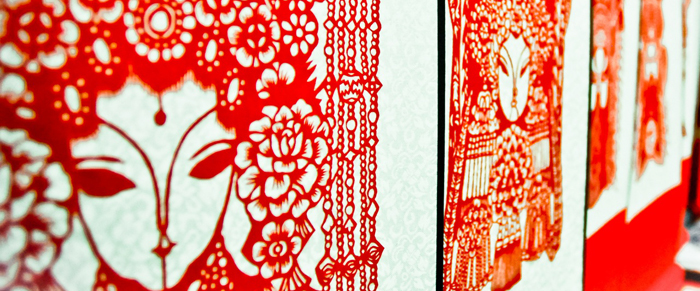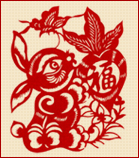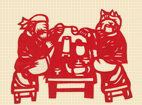

History
| | Chinese Paper Cutting or Jianzhi is the first type of papercutting design, since paper was invented by Cai Lun in the Eastern Han Dynasty in China. It is a very distinctive visual art of Chinese handicrafts. The art form later spread to other parts of the world with different regions adopting their own cultural styles. After hundreds of years' development, now they have become a very popular means of decoration among country folk, especially women. Because the cut outs are also used to decorate doors and windows, they are sometimes referred to "chuāng huā" , meaning Window Flower. Today, Chinese paper-cuts are used for religious and ceremonial purposes. They are buried with the dead and burned at funerals. They were also used as offerings to ancestors and the gods |
| Additionally, paper-cuts are chiefly used as decorations. They are also to be used as patterns, especially for embroidery and lacquer wears. They can also adorn walls, windows, doors, columns, mirrors, lamps and lanterns in homes. | |
| Chinese people believe that the red paper-cuts on the door can bring good luck and happiness to the whole family. he paper-cuts are more often seen during traditional Chinese festivals, particularly in Chinese New Year, the Spring Festival. They are also given as presents or gifts to good friends or other family members. In Chinese traditional culture, paper-cuts can reflect many aspects of life such as prosperity, health, or harvest. | |
| | Symmetry There are basic cut outs, that are a single image. And there are symmetrical designs that are usually created by some folding over a proportioned crease, and then cutting some shape. When unfolded, it forms a symmetrical design. Chinese paper cuttings are normally symmetrical. The paper cut outs are usually in an even number series of 2, 4, 24 etc. Process Papercuttings are not produced by machine, but by hand. There are two methods of manufacture: one use scissors, the other use knives. |
Knife cuttings are fashioned by putting several layers of paper on a relatively soft foundation consisting of a mixture of tallow and ashes. Following a pattern, the artist cuts the motif into the paper with a sharp knife which he usually holds vertically. The advantage of knife cuttings is that considerably more papercuttings can be made in one operation than with scissor cuttings.

Different forms of Chinese Paper Cutting
Yangzhou Paper-cut
Yangzhou paper-cut is comely and fluent in lines, refined and exquisite in composition with exaggerated and compact images, constituting one of the representatives of folk paper-cut art in South China. Rice paper is mostly adopted in the paper-cut art.
|
| | | | | |
|
Yuxian Paper-cut
The cutting skill of Yuxian paper-cut embodies not only the straightforwardness and simplicity of the northern folk style, but also the delicate and elegant style of the handicraft in South China. It distinguishes itself with the artistic style of full composition, vivid shapes, flamboyant colors and unique technology.
|
| | | | | |
|
Shaanxi Paper-cut
Shaanxi folk paper-cut, though often used as patterns for embroidery, serves as windows decoration. The subjects of Shaanxi paper-cut are various in kind---human figures, birds and animals, flowers and plants, fishers and insects, all-embracing. Shaanxi paper-cut is considered to be bold and unconstrained, brief and exaggerated.
|
| | | | |
|
Foshan Paper-cut
Foshan paper-cut is a folk art developed from local folk activities mostly distributed in some villages and towns of Chancheng District and Nanhai District, Foshan City. The traditional Foshan paper-cut features mainly the themes of festival and luck, exorcising and blessing, children and longevity etc. A unique local style is shaped with the brilliant copper foils adopted in the paper-cut.
|
| | | | |
|

It is easy to learn about cutting a piece of paper but very difficult to master it with perfection. One must grasp the knife in an upright fashion and press evenly on the paper with some strength. Flexibility is required but any hesitation or wiggling will lead to imprecision or damage the whole image. Engravers stress the cutting lines in several styles. They attempt to carve a circle like the moon, a straight line like a stem of wheat, a square like a brick, and jaggedly like the beard.
| | People find hope and comfort in expressing wishes with paper cuttings. For example: for a wedding ceremony, red paper cuttings are a traditional and required decoration on the tea set, the dressing table glass, and on other furniture. A big red paper character 'Xi' (happiness) is a traditional must on the newlywed's door. Upon the birthday party of a senior, the character 'Shou' represents longevity and will add delight to the whole celebration; while a pattern of plump children cuddling fish signifies that every year they will be abundant in wealth. |
Written by Nicolas Yang




























